Analysis of Monetary and Fiscal Policies on Inflation: A Report
VerifiedAdded on 2023/03/31
|13
|2946
|370
Report
AI Summary
This report analyzes the interplay between monetary and fiscal policies in the context of a stagnant US economy facing inflationary pressures. It explores the differing priorities of the administration and the Federal Reserve, particularly in the lead-up to a Federal Reserve chairman appointment and an upcoming election. The report examines how the administration might prioritize economic growth through expansionary monetary policies, such as lowering interest rates and increasing money supply, while the Federal Reserve might focus on managing inflation. The analysis further delves into how government actions influence interest rates, inflation, employment, output, and demand, forecasting the potential impact of various policy decisions on the firm's product demand and the overall economic conditions. The report also considers the effects of policy on expectations of future economic performance. The report concludes by analyzing the effects of policy implementation on inflation and economic growth in the US.
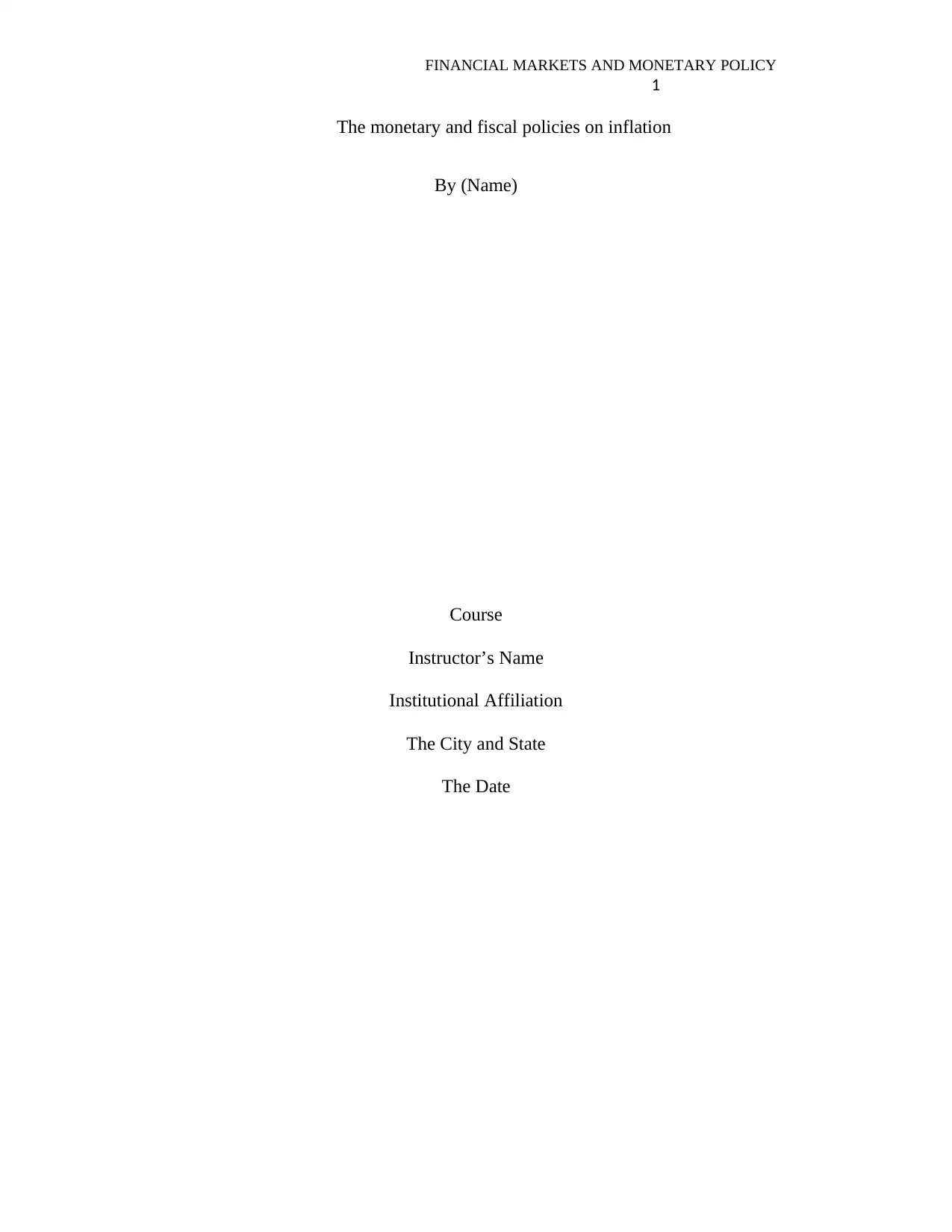
FINANCIAL MARKETS AND MONETARY POLICY
1
The monetary and fiscal policies on inflation
By (Name)
Course
Instructor’s Name
Institutional Affiliation
The City and State
The Date
1
The monetary and fiscal policies on inflation
By (Name)
Course
Instructor’s Name
Institutional Affiliation
The City and State
The Date
Paraphrase This Document
Need a fresh take? Get an instant paraphrase of this document with our AI Paraphraser
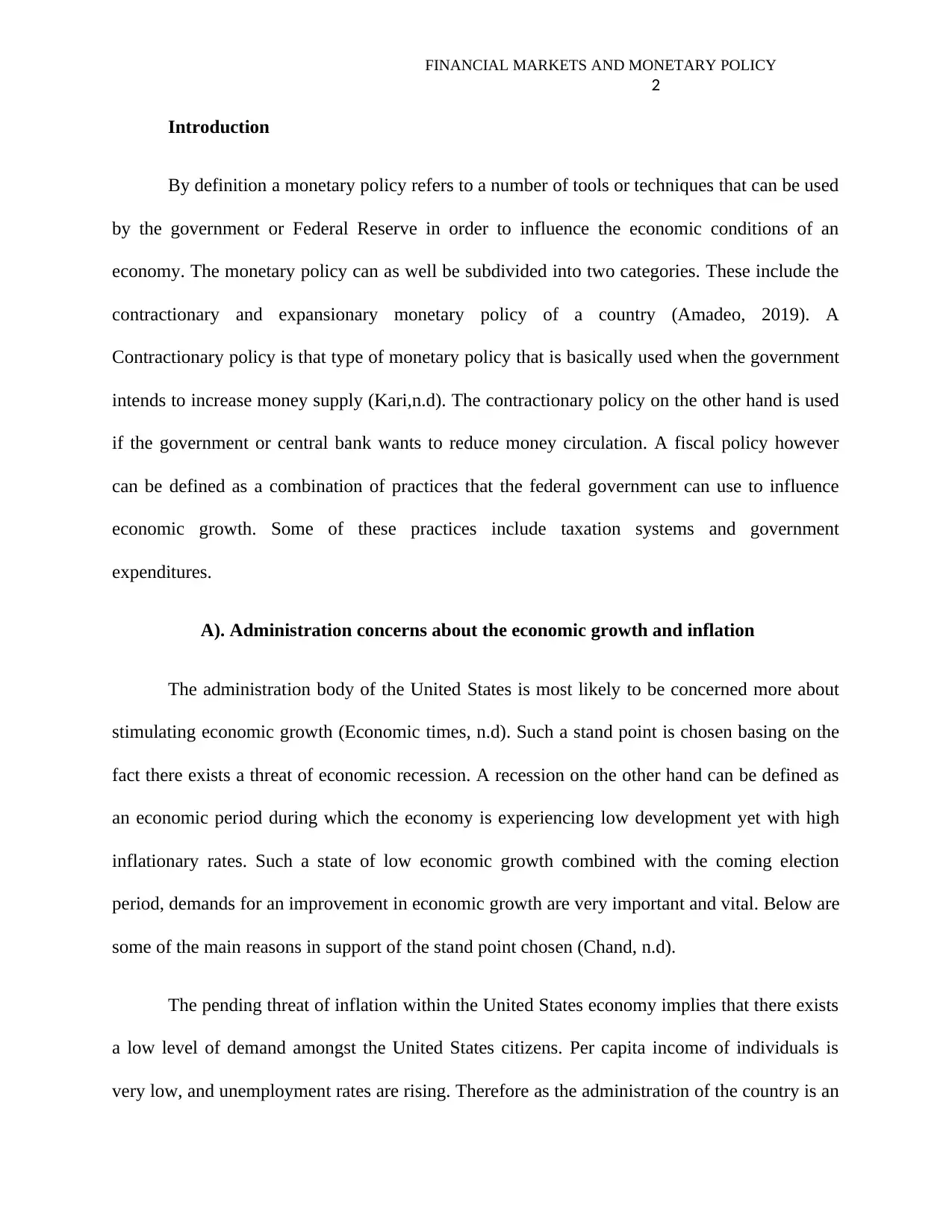
FINANCIAL MARKETS AND MONETARY POLICY
2
Introduction
By definition a monetary policy refers to a number of tools or techniques that can be used
by the government or Federal Reserve in order to influence the economic conditions of an
economy. The monetary policy can as well be subdivided into two categories. These include the
contractionary and expansionary monetary policy of a country (Amadeo, 2019). A
Contractionary policy is that type of monetary policy that is basically used when the government
intends to increase money supply (Kari,n.d). The contractionary policy on the other hand is used
if the government or central bank wants to reduce money circulation. A fiscal policy however
can be defined as a combination of practices that the federal government can use to influence
economic growth. Some of these practices include taxation systems and government
expenditures.
A). Administration concerns about the economic growth and inflation
The administration body of the United States is most likely to be concerned more about
stimulating economic growth (Economic times, n.d). Such a stand point is chosen basing on the
fact there exists a threat of economic recession. A recession on the other hand can be defined as
an economic period during which the economy is experiencing low development yet with high
inflationary rates. Such a state of low economic growth combined with the coming election
period, demands for an improvement in economic growth are very important and vital. Below are
some of the main reasons in support of the stand point chosen (Chand, n.d).
The pending threat of inflation within the United States economy implies that there exists
a low level of demand amongst the United States citizens. Per capita income of individuals is
very low, and unemployment rates are rising. Therefore as the administration of the country is an
2
Introduction
By definition a monetary policy refers to a number of tools or techniques that can be used
by the government or Federal Reserve in order to influence the economic conditions of an
economy. The monetary policy can as well be subdivided into two categories. These include the
contractionary and expansionary monetary policy of a country (Amadeo, 2019). A
Contractionary policy is that type of monetary policy that is basically used when the government
intends to increase money supply (Kari,n.d). The contractionary policy on the other hand is used
if the government or central bank wants to reduce money circulation. A fiscal policy however
can be defined as a combination of practices that the federal government can use to influence
economic growth. Some of these practices include taxation systems and government
expenditures.
A). Administration concerns about the economic growth and inflation
The administration body of the United States is most likely to be concerned more about
stimulating economic growth (Economic times, n.d). Such a stand point is chosen basing on the
fact there exists a threat of economic recession. A recession on the other hand can be defined as
an economic period during which the economy is experiencing low development yet with high
inflationary rates. Such a state of low economic growth combined with the coming election
period, demands for an improvement in economic growth are very important and vital. Below are
some of the main reasons in support of the stand point chosen (Chand, n.d).
The pending threat of inflation within the United States economy implies that there exists
a low level of demand amongst the United States citizens. Per capita income of individuals is
very low, and unemployment rates are rising. Therefore as the administration of the country is an
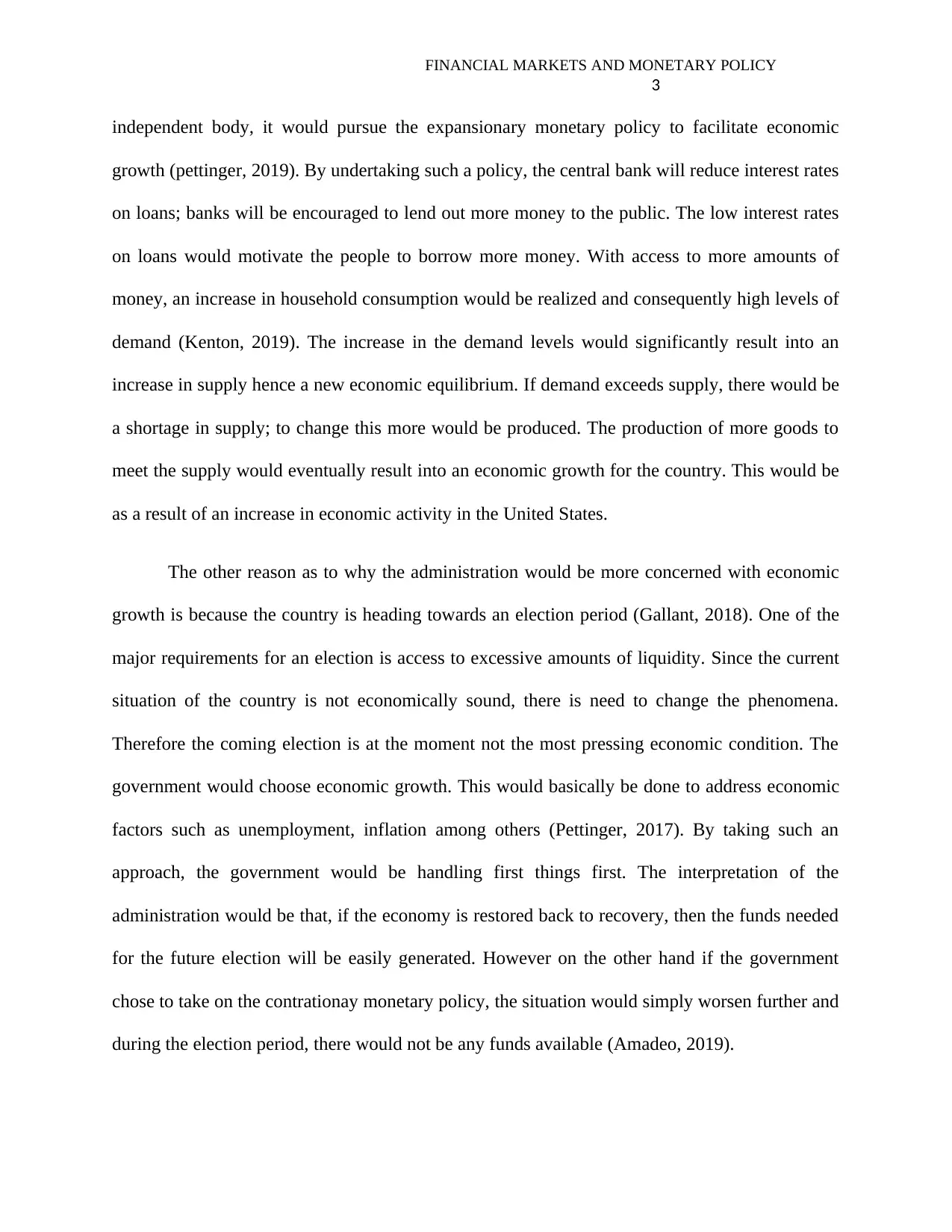
FINANCIAL MARKETS AND MONETARY POLICY
3
independent body, it would pursue the expansionary monetary policy to facilitate economic
growth (pettinger, 2019). By undertaking such a policy, the central bank will reduce interest rates
on loans; banks will be encouraged to lend out more money to the public. The low interest rates
on loans would motivate the people to borrow more money. With access to more amounts of
money, an increase in household consumption would be realized and consequently high levels of
demand (Kenton, 2019). The increase in the demand levels would significantly result into an
increase in supply hence a new economic equilibrium. If demand exceeds supply, there would be
a shortage in supply; to change this more would be produced. The production of more goods to
meet the supply would eventually result into an economic growth for the country. This would be
as a result of an increase in economic activity in the United States.
The other reason as to why the administration would be more concerned with economic
growth is because the country is heading towards an election period (Gallant, 2018). One of the
major requirements for an election is access to excessive amounts of liquidity. Since the current
situation of the country is not economically sound, there is need to change the phenomena.
Therefore the coming election is at the moment not the most pressing economic condition. The
government would choose economic growth. This would basically be done to address economic
factors such as unemployment, inflation among others (Pettinger, 2017). By taking such an
approach, the government would be handling first things first. The interpretation of the
administration would be that, if the economy is restored back to recovery, then the funds needed
for the future election will be easily generated. However on the other hand if the government
chose to take on the contrationay monetary policy, the situation would simply worsen further and
during the election period, there would not be any funds available (Amadeo, 2019).
3
independent body, it would pursue the expansionary monetary policy to facilitate economic
growth (pettinger, 2019). By undertaking such a policy, the central bank will reduce interest rates
on loans; banks will be encouraged to lend out more money to the public. The low interest rates
on loans would motivate the people to borrow more money. With access to more amounts of
money, an increase in household consumption would be realized and consequently high levels of
demand (Kenton, 2019). The increase in the demand levels would significantly result into an
increase in supply hence a new economic equilibrium. If demand exceeds supply, there would be
a shortage in supply; to change this more would be produced. The production of more goods to
meet the supply would eventually result into an economic growth for the country. This would be
as a result of an increase in economic activity in the United States.
The other reason as to why the administration would be more concerned with economic
growth is because the country is heading towards an election period (Gallant, 2018). One of the
major requirements for an election is access to excessive amounts of liquidity. Since the current
situation of the country is not economically sound, there is need to change the phenomena.
Therefore the coming election is at the moment not the most pressing economic condition. The
government would choose economic growth. This would basically be done to address economic
factors such as unemployment, inflation among others (Pettinger, 2017). By taking such an
approach, the government would be handling first things first. The interpretation of the
administration would be that, if the economy is restored back to recovery, then the funds needed
for the future election will be easily generated. However on the other hand if the government
chose to take on the contrationay monetary policy, the situation would simply worsen further and
during the election period, there would not be any funds available (Amadeo, 2019).
⊘ This is a preview!⊘
Do you want full access?
Subscribe today to unlock all pages.

Trusted by 1+ million students worldwide
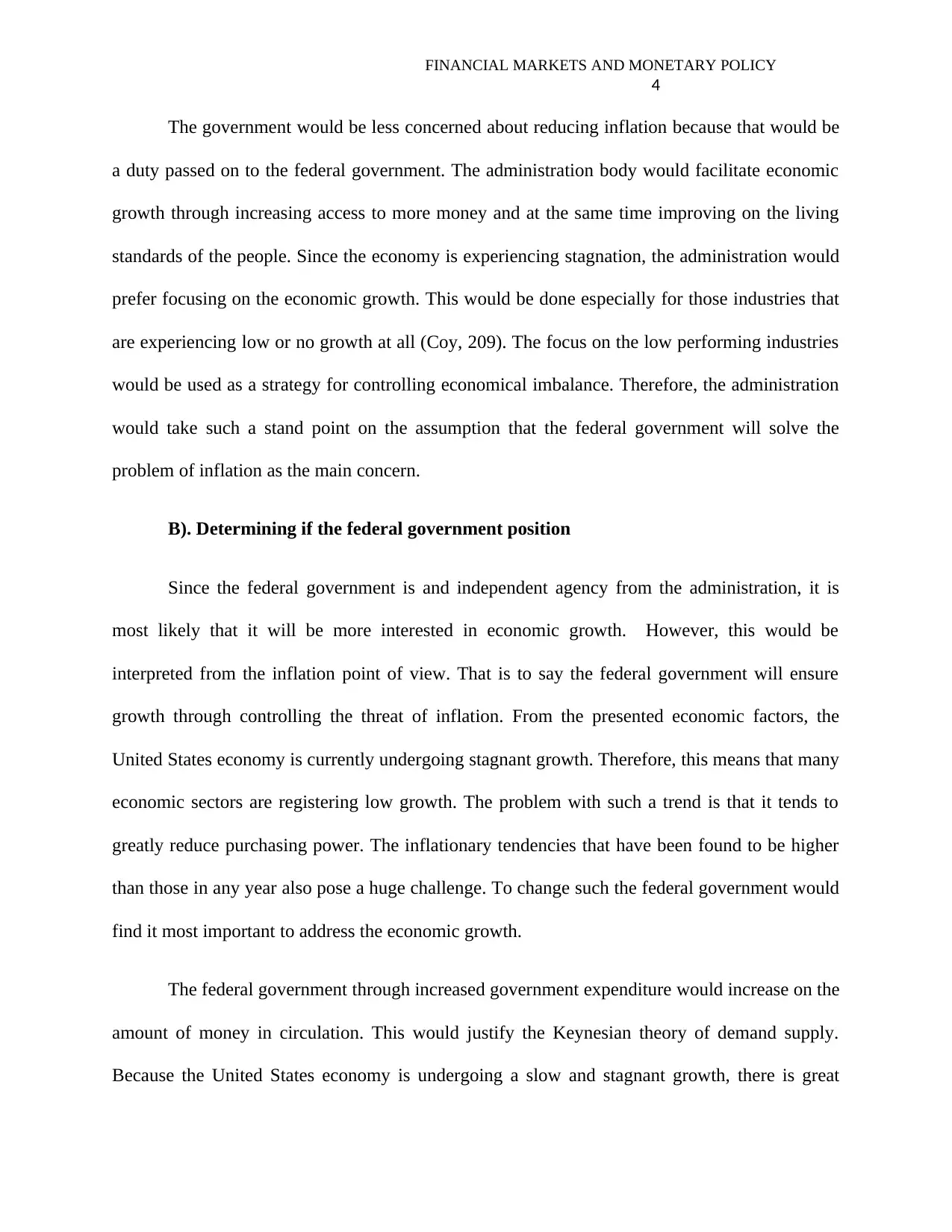
FINANCIAL MARKETS AND MONETARY POLICY
4
The government would be less concerned about reducing inflation because that would be
a duty passed on to the federal government. The administration body would facilitate economic
growth through increasing access to more money and at the same time improving on the living
standards of the people. Since the economy is experiencing stagnation, the administration would
prefer focusing on the economic growth. This would be done especially for those industries that
are experiencing low or no growth at all (Coy, 209). The focus on the low performing industries
would be used as a strategy for controlling economical imbalance. Therefore, the administration
would take such a stand point on the assumption that the federal government will solve the
problem of inflation as the main concern.
B). Determining if the federal government position
Since the federal government is and independent agency from the administration, it is
most likely that it will be more interested in economic growth. However, this would be
interpreted from the inflation point of view. That is to say the federal government will ensure
growth through controlling the threat of inflation. From the presented economic factors, the
United States economy is currently undergoing stagnant growth. Therefore, this means that many
economic sectors are registering low growth. The problem with such a trend is that it tends to
greatly reduce purchasing power. The inflationary tendencies that have been found to be higher
than those in any year also pose a huge challenge. To change such the federal government would
find it most important to address the economic growth.
The federal government through increased government expenditure would increase on the
amount of money in circulation. This would justify the Keynesian theory of demand supply.
Because the United States economy is undergoing a slow and stagnant growth, there is great
4
The government would be less concerned about reducing inflation because that would be
a duty passed on to the federal government. The administration body would facilitate economic
growth through increasing access to more money and at the same time improving on the living
standards of the people. Since the economy is experiencing stagnation, the administration would
prefer focusing on the economic growth. This would be done especially for those industries that
are experiencing low or no growth at all (Coy, 209). The focus on the low performing industries
would be used as a strategy for controlling economical imbalance. Therefore, the administration
would take such a stand point on the assumption that the federal government will solve the
problem of inflation as the main concern.
B). Determining if the federal government position
Since the federal government is and independent agency from the administration, it is
most likely that it will be more interested in economic growth. However, this would be
interpreted from the inflation point of view. That is to say the federal government will ensure
growth through controlling the threat of inflation. From the presented economic factors, the
United States economy is currently undergoing stagnant growth. Therefore, this means that many
economic sectors are registering low growth. The problem with such a trend is that it tends to
greatly reduce purchasing power. The inflationary tendencies that have been found to be higher
than those in any year also pose a huge challenge. To change such the federal government would
find it most important to address the economic growth.
The federal government through increased government expenditure would increase on the
amount of money in circulation. This would justify the Keynesian theory of demand supply.
Because the United States economy is undergoing a slow and stagnant growth, there is great
Paraphrase This Document
Need a fresh take? Get an instant paraphrase of this document with our AI Paraphraser
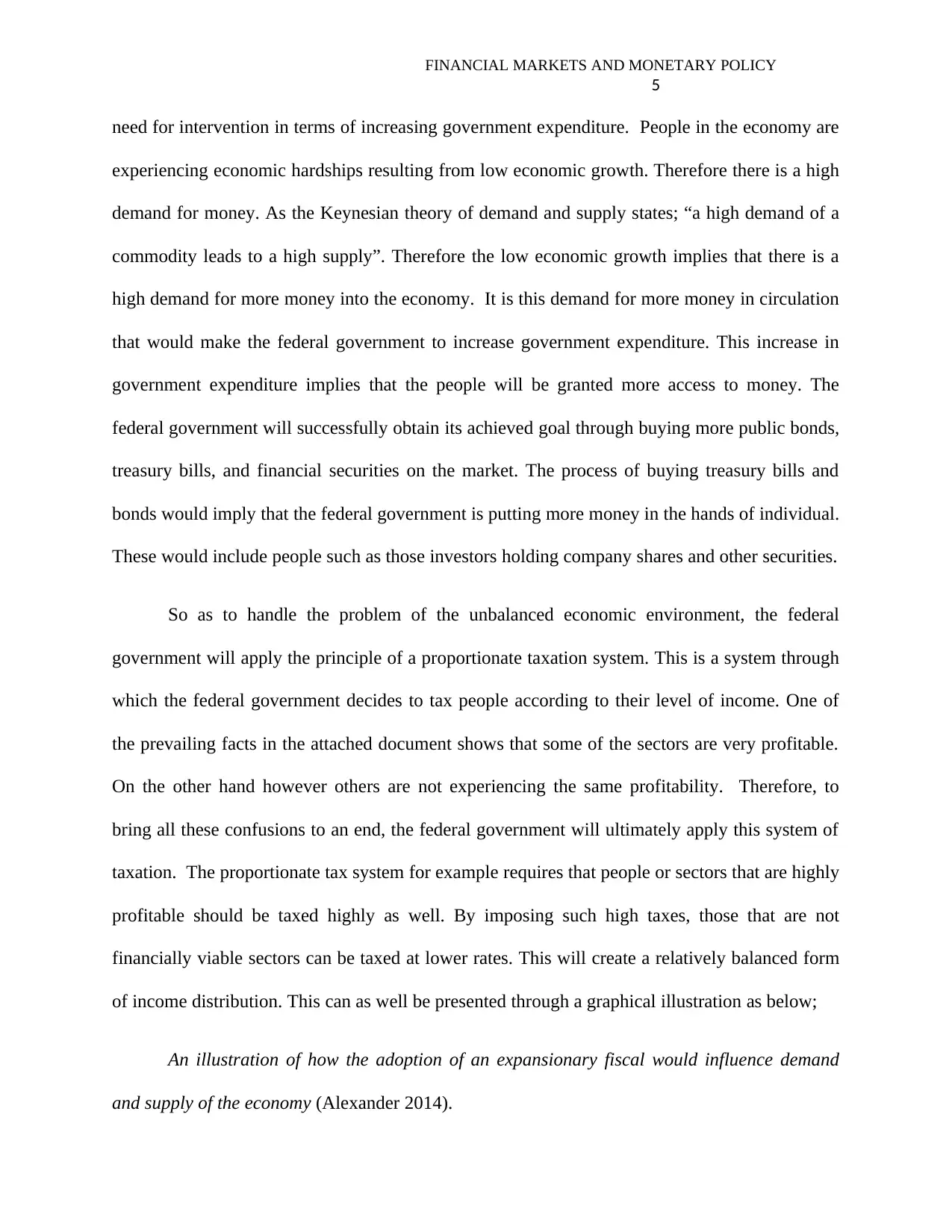
FINANCIAL MARKETS AND MONETARY POLICY
5
need for intervention in terms of increasing government expenditure. People in the economy are
experiencing economic hardships resulting from low economic growth. Therefore there is a high
demand for money. As the Keynesian theory of demand and supply states; “a high demand of a
commodity leads to a high supply”. Therefore the low economic growth implies that there is a
high demand for more money into the economy. It is this demand for more money in circulation
that would make the federal government to increase government expenditure. This increase in
government expenditure implies that the people will be granted more access to money. The
federal government will successfully obtain its achieved goal through buying more public bonds,
treasury bills, and financial securities on the market. The process of buying treasury bills and
bonds would imply that the federal government is putting more money in the hands of individual.
These would include people such as those investors holding company shares and other securities.
So as to handle the problem of the unbalanced economic environment, the federal
government will apply the principle of a proportionate taxation system. This is a system through
which the federal government decides to tax people according to their level of income. One of
the prevailing facts in the attached document shows that some of the sectors are very profitable.
On the other hand however others are not experiencing the same profitability. Therefore, to
bring all these confusions to an end, the federal government will ultimately apply this system of
taxation. The proportionate tax system for example requires that people or sectors that are highly
profitable should be taxed highly as well. By imposing such high taxes, those that are not
financially viable sectors can be taxed at lower rates. This will create a relatively balanced form
of income distribution. This can as well be presented through a graphical illustration as below;
An illustration of how the adoption of an expansionary fiscal would influence demand
and supply of the economy (Alexander 2014).
5
need for intervention in terms of increasing government expenditure. People in the economy are
experiencing economic hardships resulting from low economic growth. Therefore there is a high
demand for money. As the Keynesian theory of demand and supply states; “a high demand of a
commodity leads to a high supply”. Therefore the low economic growth implies that there is a
high demand for more money into the economy. It is this demand for more money in circulation
that would make the federal government to increase government expenditure. This increase in
government expenditure implies that the people will be granted more access to money. The
federal government will successfully obtain its achieved goal through buying more public bonds,
treasury bills, and financial securities on the market. The process of buying treasury bills and
bonds would imply that the federal government is putting more money in the hands of individual.
These would include people such as those investors holding company shares and other securities.
So as to handle the problem of the unbalanced economic environment, the federal
government will apply the principle of a proportionate taxation system. This is a system through
which the federal government decides to tax people according to their level of income. One of
the prevailing facts in the attached document shows that some of the sectors are very profitable.
On the other hand however others are not experiencing the same profitability. Therefore, to
bring all these confusions to an end, the federal government will ultimately apply this system of
taxation. The proportionate tax system for example requires that people or sectors that are highly
profitable should be taxed highly as well. By imposing such high taxes, those that are not
financially viable sectors can be taxed at lower rates. This will create a relatively balanced form
of income distribution. This can as well be presented through a graphical illustration as below;
An illustration of how the adoption of an expansionary fiscal would influence demand
and supply of the economy (Alexander 2014).
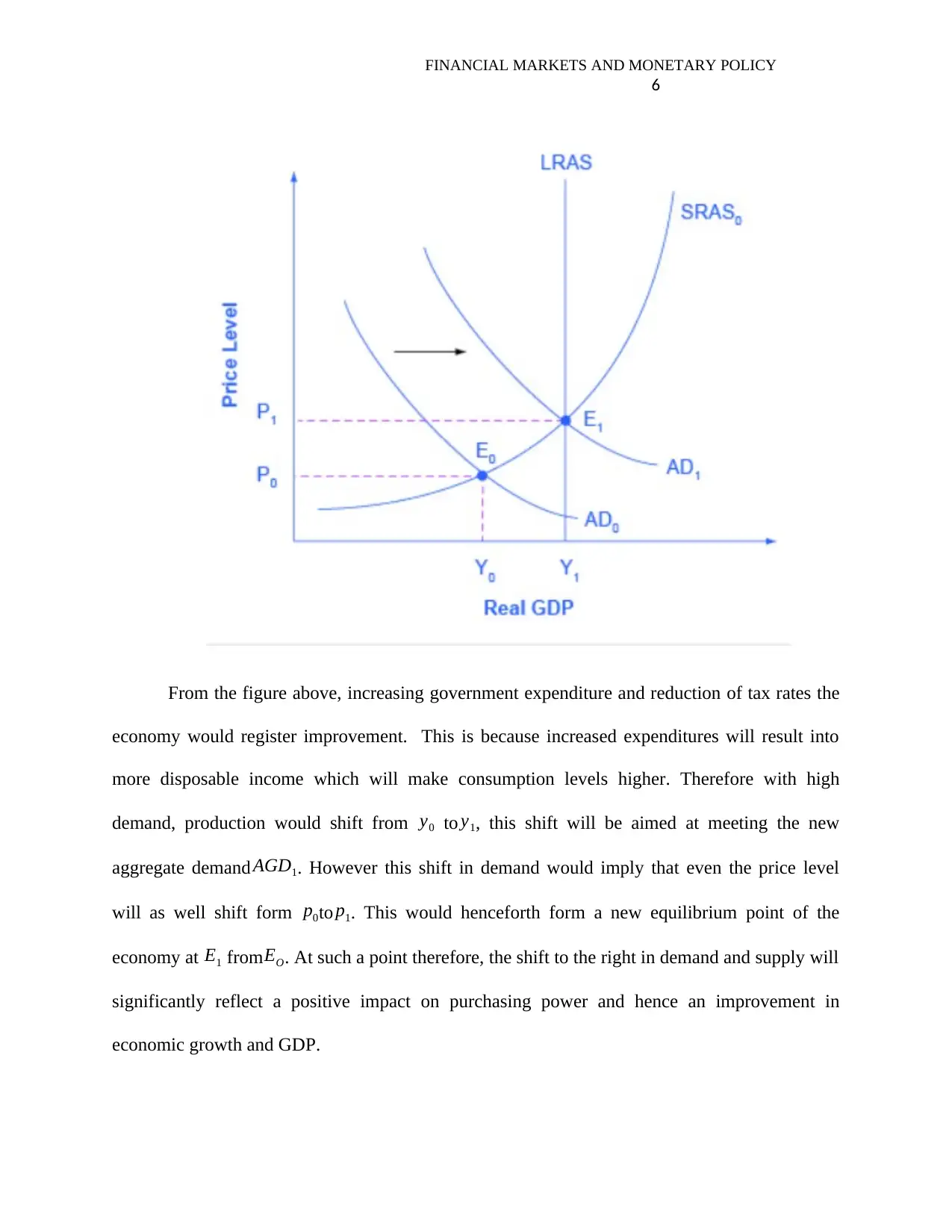
FINANCIAL MARKETS AND MONETARY POLICY
6
From the figure above, increasing government expenditure and reduction of tax rates the
economy would register improvement. This is because increased expenditures will result into
more disposable income which will make consumption levels higher. Therefore with high
demand, production would shift from y0 to y1, this shift will be aimed at meeting the new
aggregate demand AGD1. However this shift in demand would imply that even the price level
will as well shift form p0to p1. This would henceforth form a new equilibrium point of the
economy at E1 from EO. At such a point therefore, the shift to the right in demand and supply will
significantly reflect a positive impact on purchasing power and hence an improvement in
economic growth and GDP.
6
From the figure above, increasing government expenditure and reduction of tax rates the
economy would register improvement. This is because increased expenditures will result into
more disposable income which will make consumption levels higher. Therefore with high
demand, production would shift from y0 to y1, this shift will be aimed at meeting the new
aggregate demand AGD1. However this shift in demand would imply that even the price level
will as well shift form p0to p1. This would henceforth form a new equilibrium point of the
economy at E1 from EO. At such a point therefore, the shift to the right in demand and supply will
significantly reflect a positive impact on purchasing power and hence an improvement in
economic growth and GDP.
⊘ This is a preview!⊘
Do you want full access?
Subscribe today to unlock all pages.

Trusted by 1+ million students worldwide
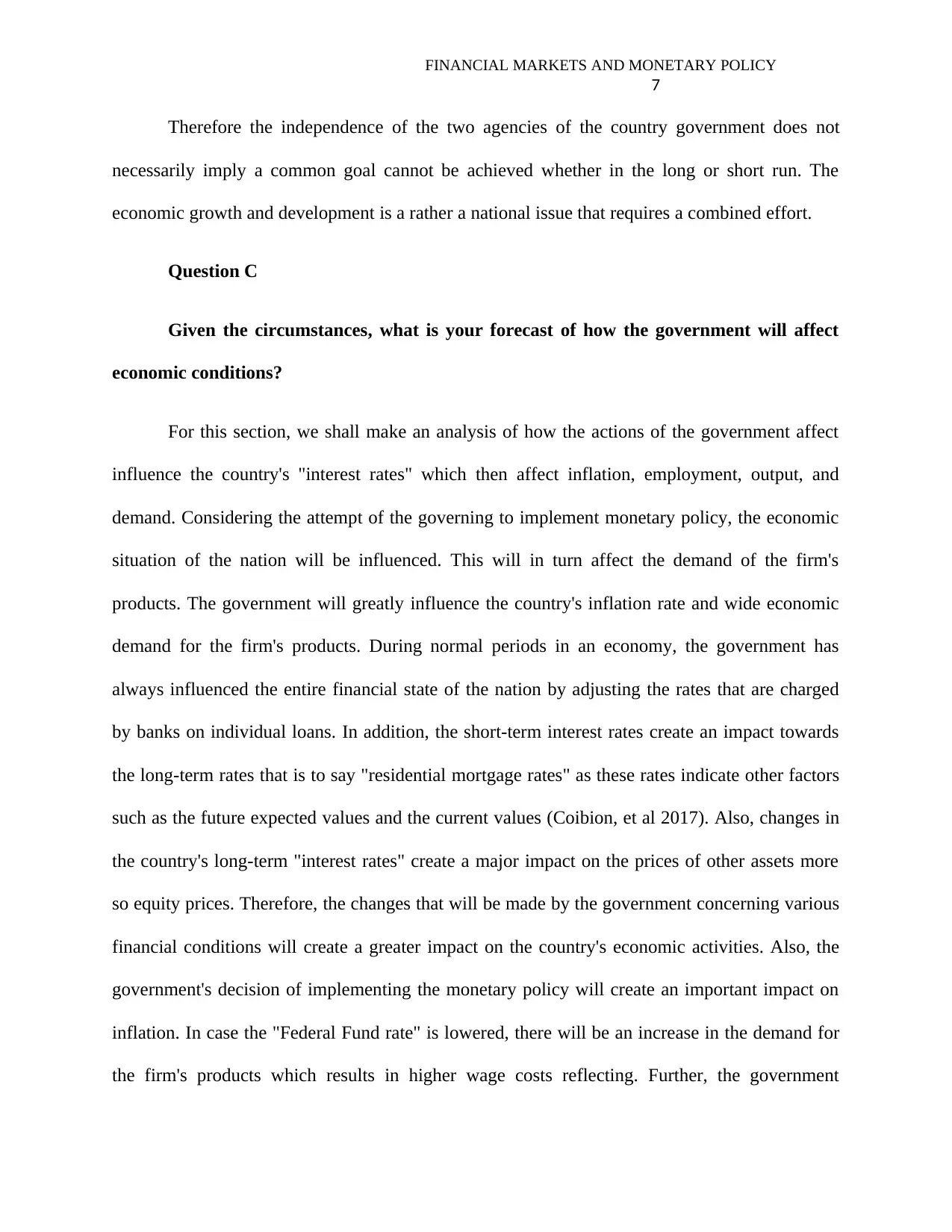
FINANCIAL MARKETS AND MONETARY POLICY
7
Therefore the independence of the two agencies of the country government does not
necessarily imply a common goal cannot be achieved whether in the long or short run. The
economic growth and development is a rather a national issue that requires a combined effort.
Question C
Given the circumstances, what is your forecast of how the government will affect
economic conditions?
For this section, we shall make an analysis of how the actions of the government affect
influence the country's "interest rates" which then affect inflation, employment, output, and
demand. Considering the attempt of the governing to implement monetary policy, the economic
situation of the nation will be influenced. This will in turn affect the demand of the firm's
products. The government will greatly influence the country's inflation rate and wide economic
demand for the firm's products. During normal periods in an economy, the government has
always influenced the entire financial state of the nation by adjusting the rates that are charged
by banks on individual loans. In addition, the short-term interest rates create an impact towards
the long-term rates that is to say "residential mortgage rates" as these rates indicate other factors
such as the future expected values and the current values (Coibion, et al 2017). Also, changes in
the country's long-term "interest rates" create a major impact on the prices of other assets more
so equity prices. Therefore, the changes that will be made by the government concerning various
financial conditions will create a greater impact on the country's economic activities. Also, the
government's decision of implementing the monetary policy will create an important impact on
inflation. In case the "Federal Fund rate" is lowered, there will be an increase in the demand for
the firm's products which results in higher wage costs reflecting. Further, the government
7
Therefore the independence of the two agencies of the country government does not
necessarily imply a common goal cannot be achieved whether in the long or short run. The
economic growth and development is a rather a national issue that requires a combined effort.
Question C
Given the circumstances, what is your forecast of how the government will affect
economic conditions?
For this section, we shall make an analysis of how the actions of the government affect
influence the country's "interest rates" which then affect inflation, employment, output, and
demand. Considering the attempt of the governing to implement monetary policy, the economic
situation of the nation will be influenced. This will in turn affect the demand of the firm's
products. The government will greatly influence the country's inflation rate and wide economic
demand for the firm's products. During normal periods in an economy, the government has
always influenced the entire financial state of the nation by adjusting the rates that are charged
by banks on individual loans. In addition, the short-term interest rates create an impact towards
the long-term rates that is to say "residential mortgage rates" as these rates indicate other factors
such as the future expected values and the current values (Coibion, et al 2017). Also, changes in
the country's long-term "interest rates" create a major impact on the prices of other assets more
so equity prices. Therefore, the changes that will be made by the government concerning various
financial conditions will create a greater impact on the country's economic activities. Also, the
government's decision of implementing the monetary policy will create an important impact on
inflation. In case the "Federal Fund rate" is lowered, there will be an increase in the demand for
the firm's products which results in higher wage costs reflecting. Further, the government
Paraphrase This Document
Need a fresh take? Get an instant paraphrase of this document with our AI Paraphraser
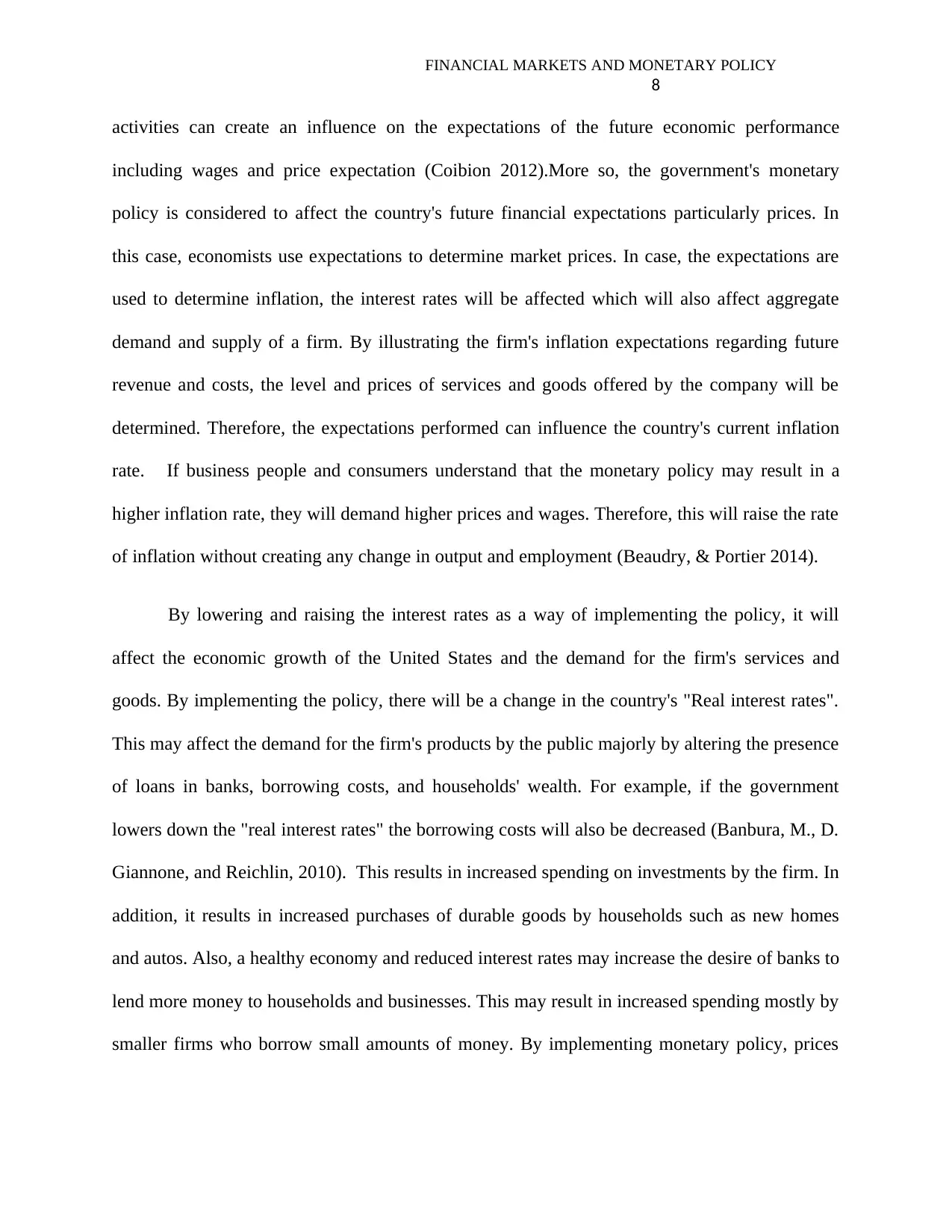
FINANCIAL MARKETS AND MONETARY POLICY
8
activities can create an influence on the expectations of the future economic performance
including wages and price expectation (Coibion 2012).More so, the government's monetary
policy is considered to affect the country's future financial expectations particularly prices. In
this case, economists use expectations to determine market prices. In case, the expectations are
used to determine inflation, the interest rates will be affected which will also affect aggregate
demand and supply of a firm. By illustrating the firm's inflation expectations regarding future
revenue and costs, the level and prices of services and goods offered by the company will be
determined. Therefore, the expectations performed can influence the country's current inflation
rate. If business people and consumers understand that the monetary policy may result in a
higher inflation rate, they will demand higher prices and wages. Therefore, this will raise the rate
of inflation without creating any change in output and employment (Beaudry, & Portier 2014).
By lowering and raising the interest rates as a way of implementing the policy, it will
affect the economic growth of the United States and the demand for the firm's services and
goods. By implementing the policy, there will be a change in the country's "Real interest rates".
This may affect the demand for the firm's products by the public majorly by altering the presence
of loans in banks, borrowing costs, and households' wealth. For example, if the government
lowers down the "real interest rates" the borrowing costs will also be decreased (Banbura, M., D.
Giannone, and Reichlin, 2010). This results in increased spending on investments by the firm. In
addition, it results in increased purchases of durable goods by households such as new homes
and autos. Also, a healthy economy and reduced interest rates may increase the desire of banks to
lend more money to households and businesses. This may result in increased spending mostly by
smaller firms who borrow small amounts of money. By implementing monetary policy, prices
8
activities can create an influence on the expectations of the future economic performance
including wages and price expectation (Coibion 2012).More so, the government's monetary
policy is considered to affect the country's future financial expectations particularly prices. In
this case, economists use expectations to determine market prices. In case, the expectations are
used to determine inflation, the interest rates will be affected which will also affect aggregate
demand and supply of a firm. By illustrating the firm's inflation expectations regarding future
revenue and costs, the level and prices of services and goods offered by the company will be
determined. Therefore, the expectations performed can influence the country's current inflation
rate. If business people and consumers understand that the monetary policy may result in a
higher inflation rate, they will demand higher prices and wages. Therefore, this will raise the rate
of inflation without creating any change in output and employment (Beaudry, & Portier 2014).
By lowering and raising the interest rates as a way of implementing the policy, it will
affect the economic growth of the United States and the demand for the firm's services and
goods. By implementing the policy, there will be a change in the country's "Real interest rates".
This may affect the demand for the firm's products by the public majorly by altering the presence
of loans in banks, borrowing costs, and households' wealth. For example, if the government
lowers down the "real interest rates" the borrowing costs will also be decreased (Banbura, M., D.
Giannone, and Reichlin, 2010). This results in increased spending on investments by the firm. In
addition, it results in increased purchases of durable goods by households such as new homes
and autos. Also, a healthy economy and reduced interest rates may increase the desire of banks to
lend more money to households and businesses. This may result in increased spending mostly by
smaller firms who borrow small amounts of money. By implementing monetary policy, prices
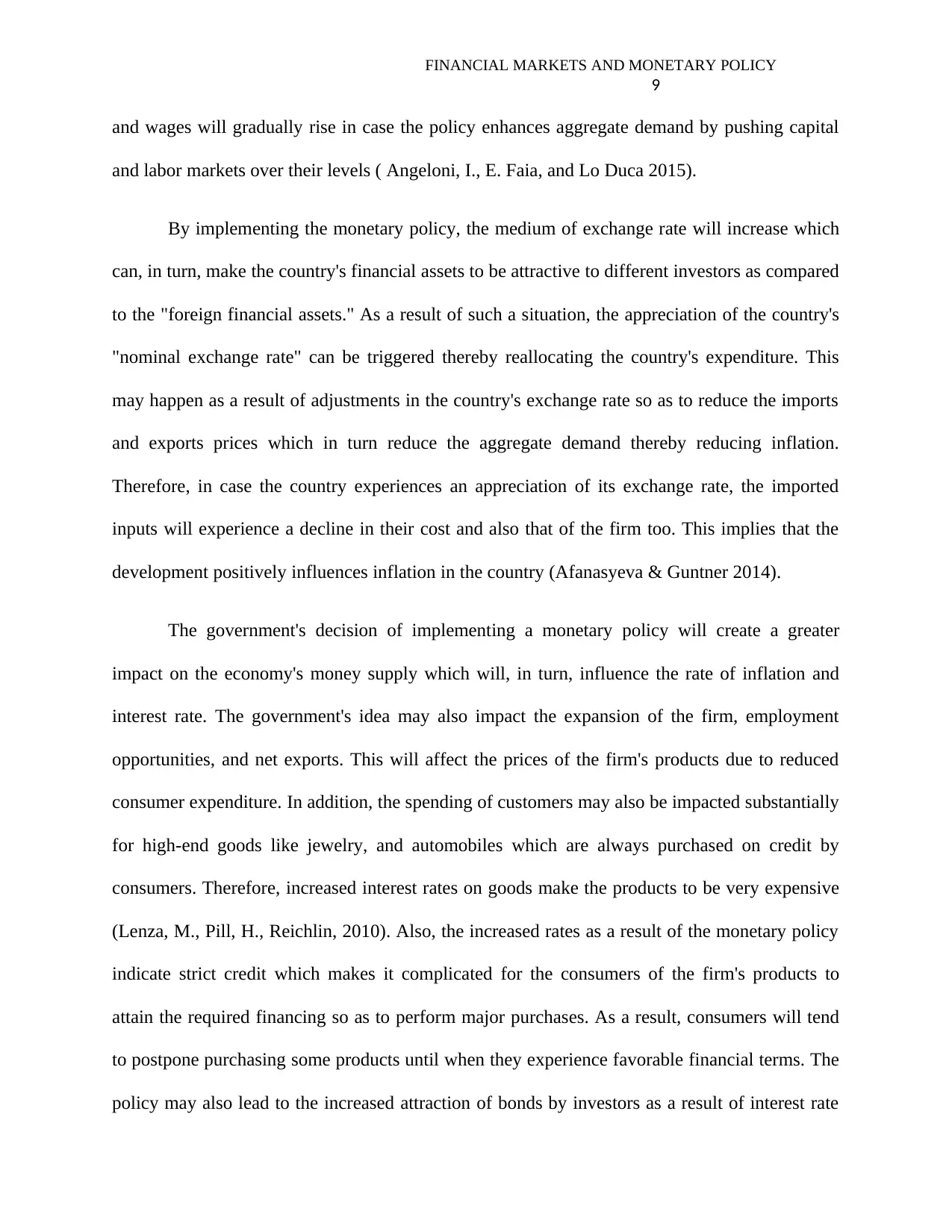
FINANCIAL MARKETS AND MONETARY POLICY
9
and wages will gradually rise in case the policy enhances aggregate demand by pushing capital
and labor markets over their levels ( Angeloni, I., E. Faia, and Lo Duca 2015).
By implementing the monetary policy, the medium of exchange rate will increase which
can, in turn, make the country's financial assets to be attractive to different investors as compared
to the "foreign financial assets." As a result of such a situation, the appreciation of the country's
"nominal exchange rate" can be triggered thereby reallocating the country's expenditure. This
may happen as a result of adjustments in the country's exchange rate so as to reduce the imports
and exports prices which in turn reduce the aggregate demand thereby reducing inflation.
Therefore, in case the country experiences an appreciation of its exchange rate, the imported
inputs will experience a decline in their cost and also that of the firm too. This implies that the
development positively influences inflation in the country (Afanasyeva & Guntner 2014).
The government's decision of implementing a monetary policy will create a greater
impact on the economy's money supply which will, in turn, influence the rate of inflation and
interest rate. The government's idea may also impact the expansion of the firm, employment
opportunities, and net exports. This will affect the prices of the firm's products due to reduced
consumer expenditure. In addition, the spending of customers may also be impacted substantially
for high-end goods like jewelry, and automobiles which are always purchased on credit by
consumers. Therefore, increased interest rates on goods make the products to be very expensive
(Lenza, M., Pill, H., Reichlin, 2010). Also, the increased rates as a result of the monetary policy
indicate strict credit which makes it complicated for the consumers of the firm's products to
attain the required financing so as to perform major purchases. As a result, consumers will tend
to postpone purchasing some products until when they experience favorable financial terms. The
policy may also lead to the increased attraction of bonds by investors as a result of interest rate
9
and wages will gradually rise in case the policy enhances aggregate demand by pushing capital
and labor markets over their levels ( Angeloni, I., E. Faia, and Lo Duca 2015).
By implementing the monetary policy, the medium of exchange rate will increase which
can, in turn, make the country's financial assets to be attractive to different investors as compared
to the "foreign financial assets." As a result of such a situation, the appreciation of the country's
"nominal exchange rate" can be triggered thereby reallocating the country's expenditure. This
may happen as a result of adjustments in the country's exchange rate so as to reduce the imports
and exports prices which in turn reduce the aggregate demand thereby reducing inflation.
Therefore, in case the country experiences an appreciation of its exchange rate, the imported
inputs will experience a decline in their cost and also that of the firm too. This implies that the
development positively influences inflation in the country (Afanasyeva & Guntner 2014).
The government's decision of implementing a monetary policy will create a greater
impact on the economy's money supply which will, in turn, influence the rate of inflation and
interest rate. The government's idea may also impact the expansion of the firm, employment
opportunities, and net exports. This will affect the prices of the firm's products due to reduced
consumer expenditure. In addition, the spending of customers may also be impacted substantially
for high-end goods like jewelry, and automobiles which are always purchased on credit by
consumers. Therefore, increased interest rates on goods make the products to be very expensive
(Lenza, M., Pill, H., Reichlin, 2010). Also, the increased rates as a result of the monetary policy
indicate strict credit which makes it complicated for the consumers of the firm's products to
attain the required financing so as to perform major purchases. As a result, consumers will tend
to postpone purchasing some products until when they experience favorable financial terms. The
policy may also lead to the increased attraction of bonds by investors as a result of interest rate
⊘ This is a preview!⊘
Do you want full access?
Subscribe today to unlock all pages.

Trusted by 1+ million students worldwide
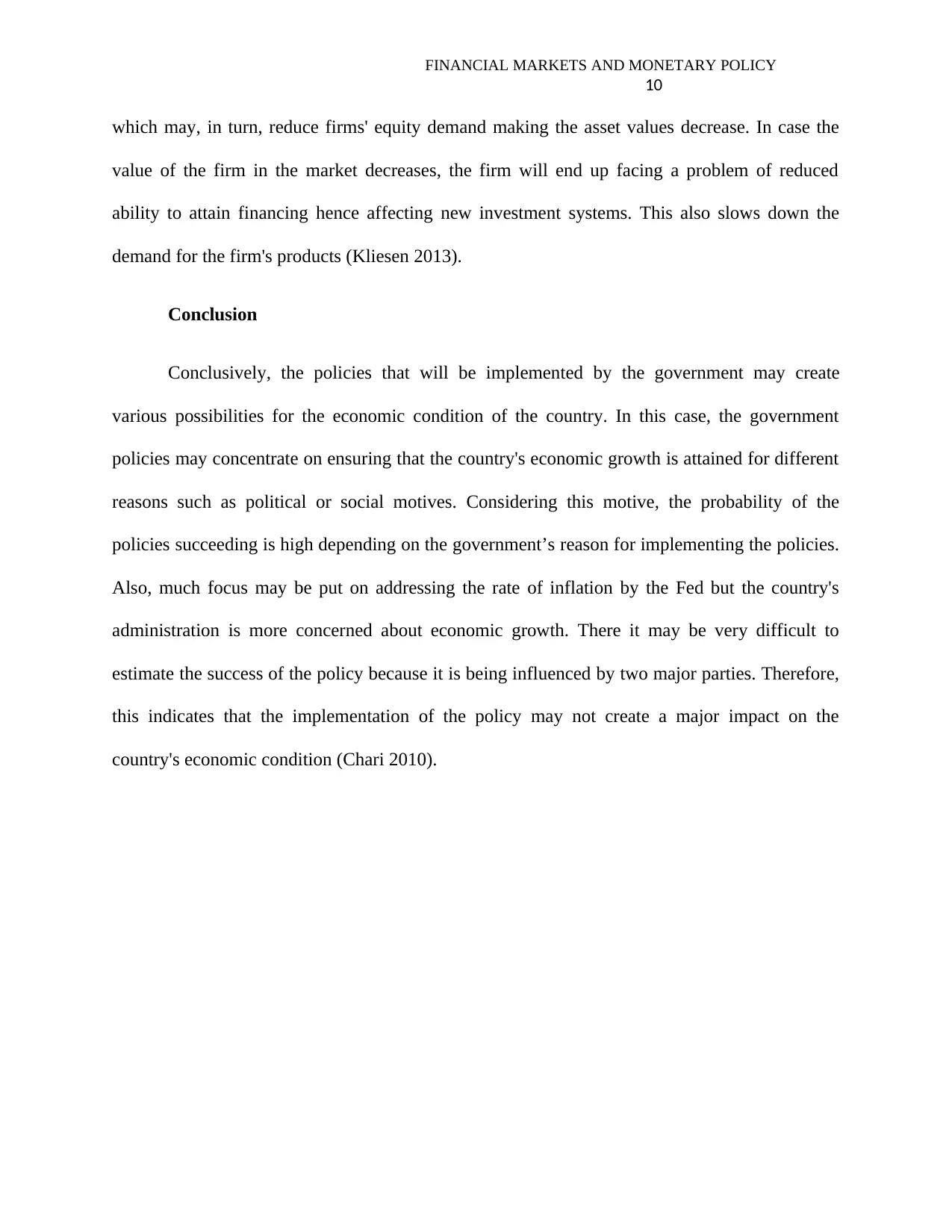
FINANCIAL MARKETS AND MONETARY POLICY
10
which may, in turn, reduce firms' equity demand making the asset values decrease. In case the
value of the firm in the market decreases, the firm will end up facing a problem of reduced
ability to attain financing hence affecting new investment systems. This also slows down the
demand for the firm's products (Kliesen 2013).
Conclusion
Conclusively, the policies that will be implemented by the government may create
various possibilities for the economic condition of the country. In this case, the government
policies may concentrate on ensuring that the country's economic growth is attained for different
reasons such as political or social motives. Considering this motive, the probability of the
policies succeeding is high depending on the government’s reason for implementing the policies.
Also, much focus may be put on addressing the rate of inflation by the Fed but the country's
administration is more concerned about economic growth. There it may be very difficult to
estimate the success of the policy because it is being influenced by two major parties. Therefore,
this indicates that the implementation of the policy may not create a major impact on the
country's economic condition (Chari 2010).
10
which may, in turn, reduce firms' equity demand making the asset values decrease. In case the
value of the firm in the market decreases, the firm will end up facing a problem of reduced
ability to attain financing hence affecting new investment systems. This also slows down the
demand for the firm's products (Kliesen 2013).
Conclusion
Conclusively, the policies that will be implemented by the government may create
various possibilities for the economic condition of the country. In this case, the government
policies may concentrate on ensuring that the country's economic growth is attained for different
reasons such as political or social motives. Considering this motive, the probability of the
policies succeeding is high depending on the government’s reason for implementing the policies.
Also, much focus may be put on addressing the rate of inflation by the Fed but the country's
administration is more concerned about economic growth. There it may be very difficult to
estimate the success of the policy because it is being influenced by two major parties. Therefore,
this indicates that the implementation of the policy may not create a major impact on the
country's economic condition (Chari 2010).
Paraphrase This Document
Need a fresh take? Get an instant paraphrase of this document with our AI Paraphraser
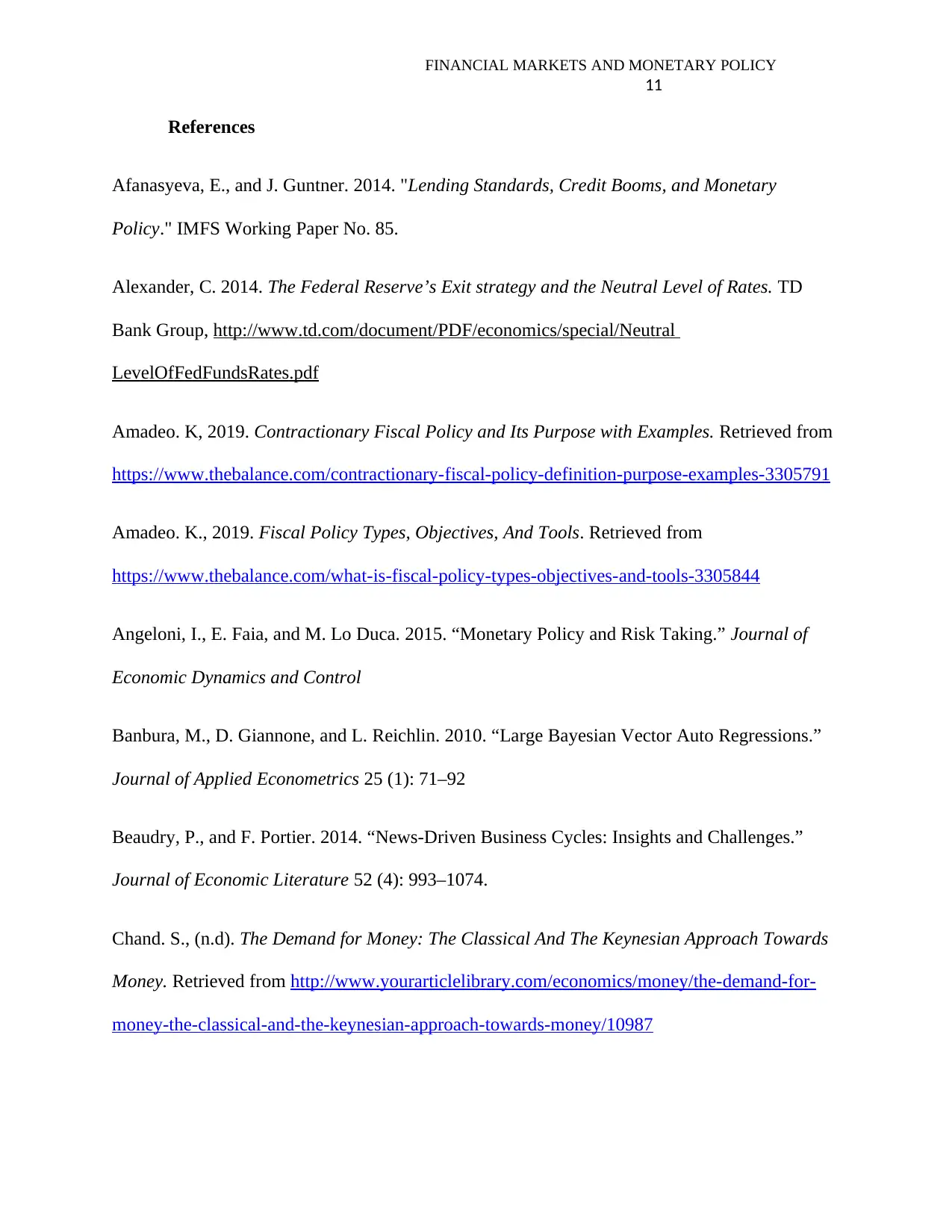
FINANCIAL MARKETS AND MONETARY POLICY
11
References
Afanasyeva, E., and J. Guntner. 2014. "Lending Standards, Credit Booms, and Monetary
Policy." IMFS Working Paper No. 85.
Alexander, C. 2014. The Federal Reserve’s Exit strategy and the Neutral Level of Rates. TD
Bank Group, http://www.td.com/document/PDF/economics/special/Neutral
LevelOfFedFundsRates.pdf
Amadeo. K, 2019. Contractionary Fiscal Policy and Its Purpose with Examples. Retrieved from
https://www.thebalance.com/contractionary-fiscal-policy-definition-purpose-examples-3305791
Amadeo. K., 2019. Fiscal Policy Types, Objectives, And Tools. Retrieved from
https://www.thebalance.com/what-is-fiscal-policy-types-objectives-and-tools-3305844
Angeloni, I., E. Faia, and M. Lo Duca. 2015. “Monetary Policy and Risk Taking.” Journal of
Economic Dynamics and Control
Banbura, M., D. Giannone, and L. Reichlin. 2010. “Large Bayesian Vector Auto Regressions.”
Journal of Applied Econometrics 25 (1): 71–92
Beaudry, P., and F. Portier. 2014. “News-Driven Business Cycles: Insights and Challenges.”
Journal of Economic Literature 52 (4): 993–1074.
Chand. S., (n.d). The Demand for Money: The Classical And The Keynesian Approach Towards
Money. Retrieved from http://www.yourarticlelibrary.com/economics/money/the-demand-for-
money-the-classical-and-the-keynesian-approach-towards-money/10987
11
References
Afanasyeva, E., and J. Guntner. 2014. "Lending Standards, Credit Booms, and Monetary
Policy." IMFS Working Paper No. 85.
Alexander, C. 2014. The Federal Reserve’s Exit strategy and the Neutral Level of Rates. TD
Bank Group, http://www.td.com/document/PDF/economics/special/Neutral
LevelOfFedFundsRates.pdf
Amadeo. K, 2019. Contractionary Fiscal Policy and Its Purpose with Examples. Retrieved from
https://www.thebalance.com/contractionary-fiscal-policy-definition-purpose-examples-3305791
Amadeo. K., 2019. Fiscal Policy Types, Objectives, And Tools. Retrieved from
https://www.thebalance.com/what-is-fiscal-policy-types-objectives-and-tools-3305844
Angeloni, I., E. Faia, and M. Lo Duca. 2015. “Monetary Policy and Risk Taking.” Journal of
Economic Dynamics and Control
Banbura, M., D. Giannone, and L. Reichlin. 2010. “Large Bayesian Vector Auto Regressions.”
Journal of Applied Econometrics 25 (1): 71–92
Beaudry, P., and F. Portier. 2014. “News-Driven Business Cycles: Insights and Challenges.”
Journal of Economic Literature 52 (4): 993–1074.
Chand. S., (n.d). The Demand for Money: The Classical And The Keynesian Approach Towards
Money. Retrieved from http://www.yourarticlelibrary.com/economics/money/the-demand-for-
money-the-classical-and-the-keynesian-approach-towards-money/10987
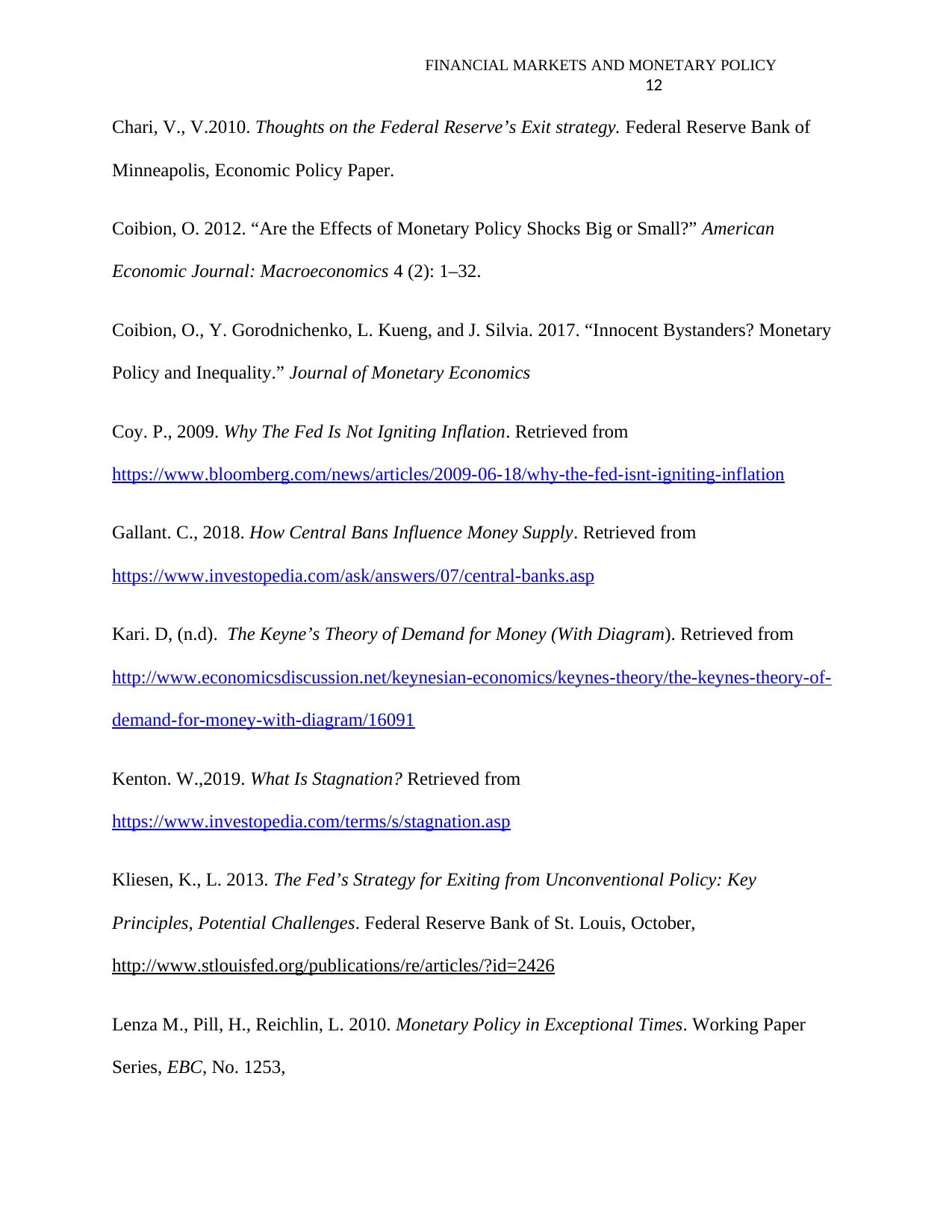
FINANCIAL MARKETS AND MONETARY POLICY
12
Chari, V., V.2010. Thoughts on the Federal Reserve’s Exit strategy. Federal Reserve Bank of
Minneapolis, Economic Policy Paper.
Coibion, O. 2012. “Are the Effects of Monetary Policy Shocks Big or Small?” American
Economic Journal: Macroeconomics 4 (2): 1–32.
Coibion, O., Y. Gorodnichenko, L. Kueng, and J. Silvia. 2017. “Innocent Bystanders? Monetary
Policy and Inequality.” Journal of Monetary Economics
Coy. P., 2009. Why The Fed Is Not Igniting Inflation. Retrieved from
https://www.bloomberg.com/news/articles/2009-06-18/why-the-fed-isnt-igniting-inflation
Gallant. C., 2018. How Central Bans Influence Money Supply. Retrieved from
https://www.investopedia.com/ask/answers/07/central-banks.asp
Kari. D, (n.d). The Keyne’s Theory of Demand for Money (With Diagram). Retrieved from
http://www.economicsdiscussion.net/keynesian-economics/keynes-theory/the-keynes-theory-of-
demand-for-money-with-diagram/16091
Kenton. W.,2019. What Is Stagnation? Retrieved from
https://www.investopedia.com/terms/s/stagnation.asp
Kliesen, K., L. 2013. The Fed’s Strategy for Exiting from Unconventional Policy: Key
Principles, Potential Challenges. Federal Reserve Bank of St. Louis, October,
http://www.stlouisfed.org/publications/re/articles/?id=2426
Lenza M., Pill, H., Reichlin, L. 2010. Monetary Policy in Exceptional Times. Working Paper
Series, EBC, No. 1253,
12
Chari, V., V.2010. Thoughts on the Federal Reserve’s Exit strategy. Federal Reserve Bank of
Minneapolis, Economic Policy Paper.
Coibion, O. 2012. “Are the Effects of Monetary Policy Shocks Big or Small?” American
Economic Journal: Macroeconomics 4 (2): 1–32.
Coibion, O., Y. Gorodnichenko, L. Kueng, and J. Silvia. 2017. “Innocent Bystanders? Monetary
Policy and Inequality.” Journal of Monetary Economics
Coy. P., 2009. Why The Fed Is Not Igniting Inflation. Retrieved from
https://www.bloomberg.com/news/articles/2009-06-18/why-the-fed-isnt-igniting-inflation
Gallant. C., 2018. How Central Bans Influence Money Supply. Retrieved from
https://www.investopedia.com/ask/answers/07/central-banks.asp
Kari. D, (n.d). The Keyne’s Theory of Demand for Money (With Diagram). Retrieved from
http://www.economicsdiscussion.net/keynesian-economics/keynes-theory/the-keynes-theory-of-
demand-for-money-with-diagram/16091
Kenton. W.,2019. What Is Stagnation? Retrieved from
https://www.investopedia.com/terms/s/stagnation.asp
Kliesen, K., L. 2013. The Fed’s Strategy for Exiting from Unconventional Policy: Key
Principles, Potential Challenges. Federal Reserve Bank of St. Louis, October,
http://www.stlouisfed.org/publications/re/articles/?id=2426
Lenza M., Pill, H., Reichlin, L. 2010. Monetary Policy in Exceptional Times. Working Paper
Series, EBC, No. 1253,
⊘ This is a preview!⊘
Do you want full access?
Subscribe today to unlock all pages.

Trusted by 1+ million students worldwide
1 out of 13
Related Documents
Your All-in-One AI-Powered Toolkit for Academic Success.
+13062052269
info@desklib.com
Available 24*7 on WhatsApp / Email
![[object Object]](/_next/static/media/star-bottom.7253800d.svg)
Unlock your academic potential
Copyright © 2020–2025 A2Z Services. All Rights Reserved. Developed and managed by ZUCOL.





